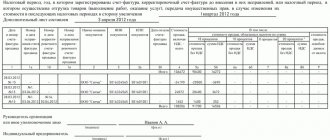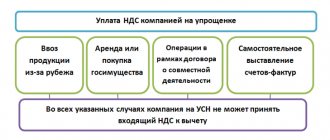VAT included in taxpayer accounting
When purchasing goods (work, services), the taxpayer receives from the supplier primary documents and invoices, which reflect the input VAT.
When importing goods, input VAT is calculated on the value reflected in the customs declaration. After receiving the documents, incoming VAT is reflected in accounting by posting: D-t 19 K-t 60(76).
Thus, input VAT is the tax imposed on the taxpayer when purchasing goods and services. It is accumulated in the debit of account 19, and is subsequently accepted for deduction if the conditions provided for in Art. 172 of the Tax Code of the Russian Federation.
Read what VAT deductions are here.
The essence of the concepts
Input VAT , also called input VAT, is incurred by those who buy something. That is, you, being a VAT payer, purchasing goods and receiving invoices for them, pay input VAT, which can then be deducted from the output tax when settling with the state budget.
Input VAT is generated at the entry of goods into the organization at the time of receipt of an invoice for the goods and its payment. You, as a buyer and taxpayer, pay the input VAT, and it is presented to you by sellers and distributors of goods or services and works provided.
output VAT to your clients when providing them with goods, services or work. When selling an object of VAT taxation, on which the payer calculates the tax amount, you issue an invoice, which indicates the output VAT.
Output VAT must be paid by the taxpayer for a certain tax period. The amount of input VAT may be deducted from it, thereby reducing the amount of tax paid to the budget by the taxpayer.
If suddenly you are provided with an advance on an advance invoice for the upcoming shipment of goods, then the amount of VAT is paid from it, and then subject to deduction after receiving the entire amount on the final invoice.
Input VAT accepted for deduction - what is it?
Art. 172 of the Tax Code of the Russian Federation requires compliance with several conditions:
- there is an invoice issued in accordance with current legislation;
- goods (works, services) are registered;
- in cases specified by law, VAT has been paid (tax agent, customs VAT);
- in the future it is assumed that the goods will be used in transactions subject to VAT.
Read more about the conditions for deducting VAT in this article.
If the specified conditions are met, the taxpayer has the right to deduct input VAT by posting D-t 68 K-t 19. After which this invoice will be registered in the purchase book, and the VAT amount will be included in section 3 of the VAT return.
ATTENTION! The Federal Tax Service has approved further changes to the VAT return form (order dated March 26, 2021 No. ED-7-3/ [email protected] ). The first time you will need to submit a report using this form is for the 3rd quarter of 2022. Find out what the changes are about here.
Incoming and outgoing VAT: formula for calculating VAT payable
The formula for calculating VAT payable to the budget is simple. To do this, the amount of incoming tax is subtracted from the amount of outgoing tax, including the actual VAT on import transactions.
VAT (U) = VAT (I) ― VAT (B)
where VAT (U) is the tax payable; VAT (I) is an outgoing tax imposed on customers; VAT (B) - input VAT received from suppliers.
Example of calculating incoming and outgoing VAT
Example. The Romashka organization purchased a batch of materials abroad in June for the amount of 30,000 rubles. I paid 18% VAT on the import of goods (5,400 rubles) in July, and in the same month received confirmation from the INFS of payment. The purchase of domestic raw materials and services in the 3rd quarter amounted to 127,440 rubles, including 18% VAT of 19,440 rubles. Goods were sold to customers in the amount of 371,700 rubles, including VAT 18% of 56,700 rubles. Advance amounts were received from buyers in the 3rd quarter for the upcoming shipment - 20,000 rubles, VAT of 18% was charged on the advance payment - 3,600 rubles.
Outgoing VAT is 56,700 +3,600 = 60,300 rubles, incoming VAT is 5,400 + 19,440 = 24,840 rubles. The tax to be transferred amounted to 60,300 – 24,840 = 35,460 rubles - this amount must be paid to Romashka LLC based on the results of the 3rd quarter.
Input VAT under simplified tax system
According to paragraph 2 of Art. 346.11 of the Tax Code of the Russian Federation, taxpayers using the simplified taxation system are not VAT payers - the only exception is the payment of VAT when importing goods into the territory of the Russian Federation and the purchase of goods (work, services) within the framework of a simple partnership (Article 174.1 of the Tax Code of the Russian Federation). Input VAT reflected in invoices when purchasing goods (works, services) is taken into account by simplifiers as expenses - this is provided for in clause 8 of Art. 346.16 Tax Code of the Russian Federation.
Find out more about how to take into account input VAT under the simplified tax system here.
VAT payers
The category of persons whose responsibilities include calculating tax are considered to be organizations and individual entrepreneurs on OSNO engaged in the sale of goods and services within the Russian Federation. These entities are recognized as payers of indirect tax.
A number of organizations and entrepreneurs whose work meets the following conditions are exempt from the need to transfer VAT to the budget:
- preferential tax regimes;
- tax exemption related to low turnover;
- sales of goods and services that are legally exempt from the need to charge VAT;
- sale of goods outside the country.
There is also a need to pay VAT as an indirect payment when importing materials and valuables into the territory of the Russian Federation. In such situations, taxation is carried out at a rate of 0%. Later, buyers independently calculate the tax on the goods received and pay it to the budget. Under these conditions, payers are all entities, regardless of the type of work, the applied taxation regime and total income.
Input VAT with separate accounting
Separate accounting of incoming VAT is provided for in clause 4 of Art. 170 of the Tax Code of the Russian Federation and is required when conducting activities related to taxable and non-VAT-taxable transactions.
When separately accounting for the amount of input VAT:
- are fully taken into account in the cost of goods (work, services) used in non-taxable transactions;
- are accepted for deduction on taxable transactions;
- for goods that are simultaneously used for taxable and non-VAT-taxable transactions, are partially (according to the calculated proportion) taken for deduction and partially taken into account in the cost of goods and services.
The method of separate accounting is fixed in the accounting policy of the taxpayer (clause 10 of article 165 of the Tax Code of the Russian Federation).
ConsultantPlus experts explained in detail how to keep separate records of “input” VAT. To do everything correctly, get trial access to the system and go to the Ready solution. It's free.
Input VAT deduction
Input VAT is paid by the seller at the time of receipt of the goods from, for example, a wholesale organization. Thus, the taxpayer has already paid the VAT amount. Then, when selling his goods, the taxpayer is obliged to present the amount of input VAT to buyers and pay it to the budget, this is the second payment of VAT. So, in order to avoid double taxation of the taxpayer, there is a procedure for deducting input VAT from the amount of output VAT.
VAT deduction is carried out on the basis of invoices received by the object of taxation from the supplier, since it is impossible to confirm in any other way the VAT payment already made.
The amount of VAT that is subject to deduction is the amount that was generated from the payment of input VAT on all invoices for the tax period.
If you, as an entrepreneur, buy imported goods abroad, then the amount of VAT paid during the process of passing the goods through customs control can be deducted as the cost of purchasing the goods. In this case, you will need documents confirming tax payment from customs.
Invoices presented for payment can be either on paper or electronically. All invoices confirming transactions carried out by the organization must be recorded in the registers - sales and purchase books, expense journals, etc.
In order for input VAT to be taken into account by the tax service, it must be reflected in the VAT return, otherwise you should not hope for a reduction in the amount of output VAT.
Input VAT cannot be deducted if the purchased goods are used in processes that are not subject to VAT, or will be used in foreign territory, or if the buyer is not a VAT payer according to the law.
Results
Input and output VAT are frequently encountered concepts in everyday life of any taxpayer.
And if input VAT can be deducted, restored, or left untouched for 3 years, then output VAT is reflected in the sales book at the time the VAT tax base is determined, and then transferred to the VAT return. You can find more complete information on the topic in ConsultantPlus. Free trial access to the system for 2 days.
Incoming and outgoing VAT
Below we will consider incoming and outgoing VAT. In the first case, the tax is indirectly paid by the buyer, and in the second case, the seller himself pays the tax.
Presentation of tax to buyers – output VAT
The tax base for calculating VAT amounts is the goods and services presented to customers with the allocated tax amount. The essence of indirect tax is a transfer to the budget by the seller at the expense of funds paid by buyers.
The obligation to present tax amounts from suppliers arises in three cases:
- upon receipt of advance amounts against future deliveries;
- when selling goods, changing ownership rights;
- if the cost of previously shipped materials is changed.
The process of selling values or services is confirmed by special documents - invoices. They are required to allocate VAT at a set rate: 10%, 18% or 0% (when moving goods across the border).
All amounts of tax presented to the buyer in this way are subject to transfer to the budget. Upon receipt of advance amounts, advance invoices are issued, which also indicate VAT. Tax accrued on advance amounts is subject to deduction after actual shipment of the goods.
Input VAT
In addition to the need to pay the tax presented to the customers to the budget, the supplier has the right to reduce the amount received by the amount of “input” VAT. Considering that the supplier of the goods can itself act as a buyer, purchasing goods or services at a price that already includes tax, double taxation is thus eliminated.
To claim the right to a deduction, you must have supplier documents with the allocated tax amount. Invoices play this role. It is not possible to confirm the input tax using any other forms. The amount of VAT deductible is the total amount of tax calculated on the basis of documents received for the tax period.
The amount of tax actually paid to the budget when purchasing imported goods is also accepted as a deduction. This requires tax payment statements confirmed by the tax office.
VAT payment deadlines
To pay tax, you need to fill out a declaration. There is a separate form for this; here you can see how to fill it out. The declaration is sent to the tax office in the same way as other reports - electronically, in person or by mail in a valuable letter with notification.
The declaration is sent once a quarter, before the 25th day of the month following the reporting period. However, you do not need to pay the entire amount at once. It is divided into equal three parts and transferred to the budget, also in parts, until the 25th day of each month of the next quarter. You can pay early.
For the first quarter, Marina sends a declaration by April 25. She needs to pay 99 thousand rubles for the entire first quarter. After sending the declaration, she transfers 33 thousand rubles, the next month, until May 25, another 33 thousand goes to the budget from Marina, and she transfers the remaining money for the first quarter until June 25.
Tax gap for VAT
Currently, tax authorities can identify the VAT tax gap automatically after receiving VAT tax returns from taxpayer organizations for the next reporting period (quarter of the current year). The purpose of searching for such VAT tax gaps is to identify shell companies and include taxpayer organizations in the appropriate “risk groups”:
- high level of risk of tax violations. In this case, taxpayer organizations in whose work there were recorded offenses have an extremely low level of compliance with their tax obligations, and therefore the likelihood of on-site inspections is especially high.
- average level of risk of tax offenses - this group includes taxpayers who partially fail to fulfill their tax obligations to accrue and timely pay taxes to the budget;
- low risk of tax violations. In this case, taxpayer organizations fulfill their obligations to accrue and timely pay taxes to the budget.
VAT gap and VAT reporting
The concept of VAT tax gaps is applied to VAT reporting and is used to indicate the amount of discrepancies in tax returns and in books of sales and purchases from counterparties.
Gaps in VAT tax returns can be identified when discrepancies are detected in the VAT amounts indicated in the books of purchases and sales of counterparties. That is, if a VAT deduction is claimed, but the operation of calculating tax and paying it to the budget for a specific transaction is not reflected in accounting.
Here are examples of situations when tax authorities identify an error such as “tax gap in VAT”:
- the business entity on whose behalf the invoice reflected in the declaration was issued did not submit tax reports for the corresponding period;
- a legal entity or individual indicated in the VAT return of the taxpayer organization is not registered with the tax office. There is no data about him in the Unified State Register of Legal Entities or Unified State Register of Entrepreneurs);
- tax gaps in the VAT return may appear in a situation where one of the counterparties provided zero VAT reporting to the tax authorities, and the second taxpayer indicated in his declaration the amount of input VAT or output tax on an invoice with this counterparty, which acts in a transaction in roles of supplier or buyer.
Thus, VAT tax gaps appear in cases where, after completing a transaction, one of the counterparties showed the VAT amount from the invoice in their VAT tax return, and the second participant in the transaction did not reflect this VAT amount in the tax reporting for the expired period.
Complex tax gaps for VAT
In a standard situation, the acting parties to the transaction are two organizations - taxpayers. This is a supplier and buyer who interact without intermediaries. If a transaction was completed with the participation of more than two organizations, and VAT discrepancies are identified at one of the stages in this chain, then the identified error will be considered a complex tax gap. In this case, tax authorities restore the chain of events between counterparty companies and compile a list of organizations participating in the operation.
Tax control measures are carried out on all identified participants in the chain. For example, tax authorities may require all primary documents for a transaction.
At the next stage, tax inspectors determine the scheme by which the counterparties worked, identify the place in the chain where the error appeared and establish the organization that is the beneficiary of the completed transaction.
Approximate diagram of the formation of a tax gap for VAT
An approximate scheme for the formation of a tax gap for VAT is as follows:
- A fly-by-night company sells goods to a transit company. Moreover, for this transaction, this organization does not report to the tax authorities and does not pay tax to the budget;
- the transit company resells this product to the final buyer or the next transit participant. In this case, the transit company charges VAT, reflects the VAT deduction and pays the tax to the budget. Thus, everything in tax accounting is done correctly;
- the buyer in a transaction with a transit company submits the VAT amount for deduction from the budget;
- Discrepancies arise between the transit company and the fly-by-night company. Tax authorities send requests to provide information on the completed transaction to all involved participants in the chain.
Ways to close VAT tax gaps
If discrepancies regarding VAT are detected, the tax authorities send a request to the taxpayer organization to provide an explanation. If the buyer organization that submitted the VAT amount for deduction can document its correctness, then the identified discrepancy will be canceled. Please note that when a VAT tax gap is identified, explanations are submitted electronically (oral testimony and paper letters are not taken into account, since the declaration on which questions arose is submitted through the TKS).
Closing VAT tax gaps can be carried out by an organization in several ways, namely:
1) The taxpayer provides the tax authorities with explanations that substantiate the reason for the identified discrepancies in VAT in the reporting period.
2) The taxpayer excludes from the VAT return the data on the invoice regarding which the tax authorities have questions, recalculates its VAT obligations and, if necessary, makes additional tax payments to the budget;
In addition, the Federal Tax Service has the right to order an inspection of the taxpayer organization, as a result of which the identified VAT error is confirmed or refuted by the tax authorities.
How are refunds made and offset against future payments?
The taxpayer has the right to dispose of that part of the refundable VAT amount that was not used to pay off debts independently. To do this, he must write an application to the tax authority and indicate the direction in which the funds will be used. In this case, refunds or offsets of amounts against future federal tax payments may occur within the following periods:
1. If the application is sent by the time the inspection makes a decision on compensation, then the procedure and timing of return or offset must comply with clause 6 of Art. 6.1, paragraphs 2, 7, 8, 11.1 art. 176 of the Tax Code of the Russian Federation. The declared amount in the above circumstances must be returned to the taxpayer’s account within 12 days from the end of the desk audit.
The tax office may not be able to meet the 12-day deadline. Then, in accordance with paragraph 10 of Art. 176 of the Tax Code of the Russian Federation, interest will begin to accrue on the delayed amount at the refinancing rate of the Central Bank of the Russian Federation.
Example:
On January 19, 2015, she submitted a tax return to the Federal Tax Service, in which a certain amount of VAT was declared for reimbursement from the budget. Simultaneously with filing the declaration, an application for tax refund is sent to the tax office. The taxpayer wanted to receive the amount indicated in the declaration into his current account.
Considering that, according to paragraph 2 of Art. 88 of the Tax Code of the Russian Federation gives 3 months for a desk audit of the tax inspectorate, then the last day of the audit will be April 19, 2015 (clause 5 of Article 6.1 of the Tax Code of the Russian Federation). If the inspection for the return of funds does not meet within 12 working days (that is, before May 7, taking into account holidays), then interest will begin to accrue from the 12th working day following the end date of the inspection - from May 7, 2015.
2. If the taxpayer sent an application later than the date of submission of the tax return, then the procedure and timing of the return or offset must comply with clause 6 of Art. 78, clause 11.1 art. 176 of the Tax Code of the Russian Federation. The declared amount must be returned within 1 month from the date the tax authority receives the application.





